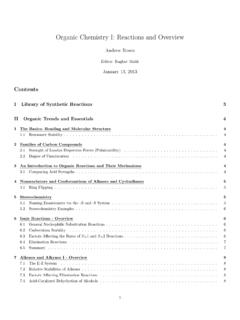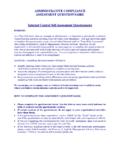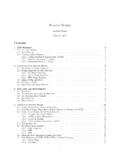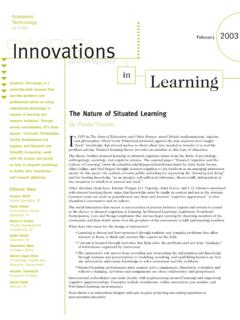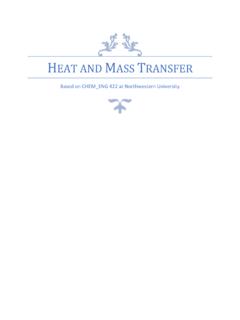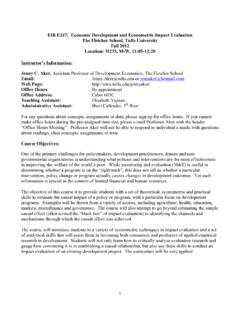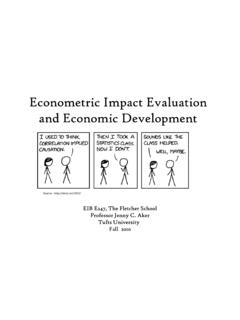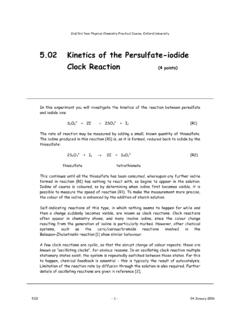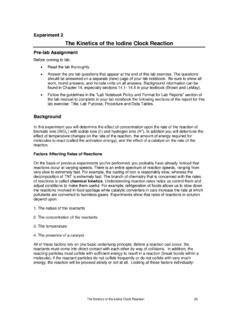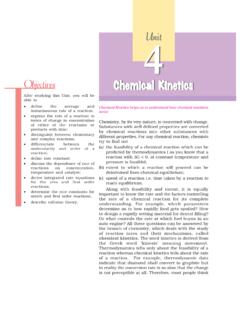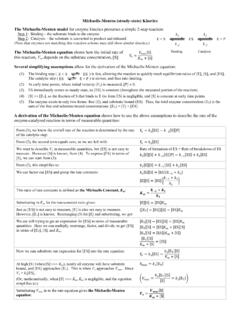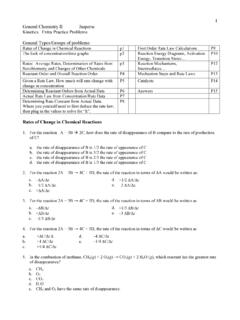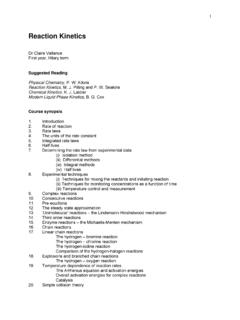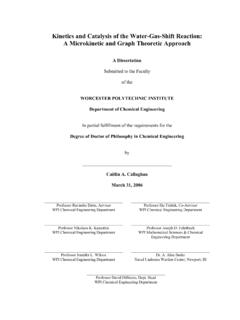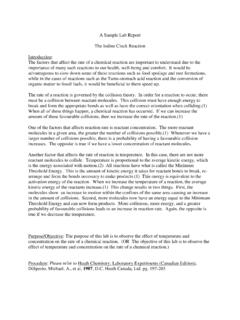Transcription of Chemical Engineering Kinetics - Tufts University
1 Chemical Engineering Kinetics Based on CHEM_ENG 408 at Northwestern University BRIEF REVIEW OF REACTOR ARCHETYPES | 1 TABLE OF CONTENTS 1 Brief Review of Reactor Archetypes .. 3 The Mass Balance .. 3 Batch Reactor .. 3 Continuous-Stirred Tank Reactor .. 4 Plug-Flow Reactor .. 4 2 Power Law Basics .. 6 Arrhenius Equation .. 6 Mass-Action Kinetics .. 7 Overview .. 7 First Order Kinetics .. 7 N-th Order Kinetics .. 7 Reversible 8 Determining the Rate Law and Rate Constants .. 9 Differential Method .. 9 Integral Method .. 10 Regression Method .. 10 Working with Pseudo Orders .. 10 3 Working with Multiple Elementary Steps .. 11 General Approach .. 11 Synthesis of HBr .. 11 Elementary Steps .. 11 Rate Expressions .. 11 The Pseudo-Steady State Hypothesis .. 12 Bond Dissociation Energies .. 12 Complex reactions : Cracking .. 12 Terminology .. 12 Mechanism and Mass-Action Kinetics .
2 13 Simplifications Based on Concentrations .. 14 Simplifications Based on Statistical Termination .. 14 Simplifications Based on the Long-Chain Approximation .. 14 Ethane Cracking Rate Law .. 14 Determining Observed Activation Energies .. 15 General Overview of Simplification Process .. 15 Complex reactions : Additives .. 16 Complex reactions : Radical Chain Autoxidation .. 16 4 Consequences of Chemical Equilibria .. 18 Relationships Between Thermodynamics and Equilibrium .. 18 Temperature-Dependence of Thermodynamic Quantities .. 18 The Equilibrium Constant .. 18 Activity Equilibrium Constant .. 18 Activities for Gases .. 19 Activities for Liquids .. 19 Relationship Between Various Equilibrium Constants .. 20 Enzyme Kinetics .. 21 Derivation of the Michaelis-Menten Equation .. 21 Plotting Michaelis-Menten Data .. 22 Reversible Product Binding .. 23 Competitive Inhibition.
3 24 Non-Competitive Inhibition .. 24 5 Reaction 25 Introduction to Reaction Networks .. 25 Delplots .. 25 BRIEF REVIEW OF REACTOR ARCHETYPES | 2 6 Kinetic Theory .. 27 Collision Theory .. 27 Distribution Laws .. 27 Collision Frequencies .. 27 Rate Constants .. 28 Lindemann Theory .. 28 Transition State Theory .. 30 Partition Functions .. 30 Computing Rates of Reaction .. 32 Thermodynamic Analysis .. 33 Hammett Equation .. 34 Taft Equation .. 35 7 Surface Catalysis .. 36 Adsorption Rate Laws .. 36 Molecular Adsorption .. 36 Dissociative Adsorption .. 37 Competitive Adsorption .. 38 Surface Reaction Rate Laws .. 39 Single Site .. 39 Dual Site .. 39 Reaction with Unbound Species .. 40 Desorption Rate Laws .. 40 Determining the Reaction Mechanism and Rate-Limiting Step .. 40 Nonidealities .. 41 Nonideal Surfaces .. 41 Sticking Probability .. 41 8 reactions in Heterogeneous Systems.
4 43 Definitions .. 43 Diffusivity .. 43 Thiele Modulus .. 43 Effectiveness Factor .. 43 Limiting Cases .. 44 No Diffusion Limitations .. 44 Diffusion Limitations .. 44 Determining if Diffusion Limitations are Dominant .. 45 Changing Particle Size .. 45 Weisz-Prater Criterion .. 46 External Mass Transfer .. 46 Mass Transfer Coefficient .. 46 Mass Transfer in Reactor 47 Nonisothermal Theory .. 47 Thin-Film Diffusion 47 BRIEF REVIEW OF REACTOR ARCHETYPES | 3 1 BRIEF REVIEW OF REACTOR ARCHETYPES THE MASS BALANCE The key equation governing processes on the reactor level is the mass balance. In order to inherently account for the proper stoichiometry, this is most typically written as a mole balance. The general mole balance for a species is given as 0 + = where 0 is the input molar flow rate, is the output molar flow rate, is the generation term, and the differential term is the accumulation.
5 If the system variables are uniform throughout the system volume, then = where is the reaction rate of species and is the system volume. More generally speaking, if changes with position in the system volume, then = such that the mole balance can be written as 0 + = Two other useful expressions that should be kept in mind are as follows. For a uniform concentration of across the system volume = Additionally, for a given flow rate = where is volumetric flow rate. BATCH REACTOR A batch reactor is a constant volume reactor has no input or output when the Chemical reaction is occurring. The batch reactor is often a good reactor archetype for slow reactions . With this information, it is clear that the batch reactor has 0= =0. As such, the mole balance is = If the reaction mixture is perfectly mixed ( spatially uniform) so that is independent of position (a common assumption for the batch reactor), then we can state = Solving for the rate of reaction of species , we see that BRIEF REVIEW OF REACTOR ARCHETYPES | 4 =1 = where is the concentration of species and the expression = was utilized.
6 Occasionally, batch reactors can be operated at a constant pressure but with a system volume that changes as a function of time. In this special case, =1 ( ) =1 ( ) ( ( ))= + ( ) CONTINUOUS-STIRRED TANK REACTOR The continuous-stirred tank reactor (CSTR) has an inlet and outlet flow of chemicals. CSTRs are operated at steady state (such that the accumulation term is zero) and are assumed to be perfectly mixed. As such, the mole balance for the CSTR can be written as 0 + =0 Solving for the reaction rate yields = 0 Utilizing the relationship of = , we can then say = 0 0 Since the system is at steady state, we know that 0 = such that the expression becomes = ( 0 ) Noting that the residence time is defined as we can simplify the rate expression as = 0 PLUG-FLOW REACTOR The plug-flow reactor (PFR) is a tubular reactor operated at steady state and has axial gradients but no radial gradients.
7 These types of reactors are useful for fast reactions that could not be as easily observed in a batch environment. Since the concentration varies continuously down the reactor tube, so does the reaction rate (except for zeroth order reactions ). For a PFR, the design equation can be solved by differentiating the mole balance with respect to volume, but an easier way is to perform a mole balance on species in a differential segment of the reactor volume, . This differential balance can be written as ( ) ( + )+ =0 BRIEF REVIEW OF REACTOR ARCHETYPES | 5 since the system is in steady state. Solving for the rate, dividing by , and letting it approach zero (while applying the definition of the derivative) yields = Once again substituting in for / and = (assuming steady state conditions such that is constant) yields = Note that the design equation can be written in terms of the length of the reactor, , and the cross-sectional area, , if.
8 Occasionally, with PFRs, the superficial velocity will be referred to, which is simply / . POWER LAW BASICS | 6 2 POWER LAW BASICS ARRHENIUS EQUATION The main assumption behind the Arrhenius expression is that = ( ) ( ). This is an approximation, but it works quite well. The rate coefficient is the term that is a function of temperature but may also depend on things like catalyst or solvent. Empirically, the Arrhenius expression states that = 0 where is the rate coefficient, 0 is the pre-exponential factor, is the activation energy, is the temperature, and is the ideal gas constant. By linearizing the equation, one finds that ln( )= (1 )+ln( ) such that plotting ln( ) vs. 1/ should yield a straight line of slope / and -intercept of ln( ). To find the ratio of two rate coefficients and two temperatures, 2 1=exp( (1 2 1 1)) To provide context, the Arrhenius expression is based on the Van t Hoff expression, which states that ln = rxn 2 If we state that is the rate coefficient, replace rxn with for the activation energy, assume that ( ) and 0 ( ), and integrate then we will arrive at the Arrhenius equation.
9 This is shown a little more rigorously below. Assume that we have a unimolecular reaction, such as the isomerization reaction with forward reaction rate , reverse reaction rate , and equilibrium constant / . The Van t Hoff equation can be written as ln = rxn 2 which can also be expressed as ln( ) = rxn 2 and thereby (ln ) (ln ) = rxn 2 Arbitrarily, we set rxn= such that the expression becomes (ln ) (ln ) = 2 2 POWER LAW BASICS | 7 Separating the forward and reverse components and integrating will yield the Arrhenius expression in the forward and reverse directions, respectively. MASS-ACTION Kinetics OVERVIEW We assume that rates can be described by Rate= ( ) ( ) where ( ) is the rate constant from Arrhenius law and ( ) is the rate law. Empirically, we say that ( )= .. which is typical rate law Kinetics . In this expression, if.
10 Are the stoichiometric coefficients of a reaction, it may be (but is not necessarily) an elementary step. Typically, we find that for elementary steps ..<3. FIRST ORDER Kinetics We will start by considering the elementary reaction The rate law can be given by = Integrating this expression yields 1 0= 0 which becomes ln( 0)= and thereby = 0 and a plot of ln( ) vs. should be linear for first order Kinetics . The half-life can be given by 12=ln(2) N-TH ORDER Kinetics The above process can be done for any integer . We will consider the general reaction The rate law can be given by POWER LAW BASICS | 8 = Integrating this expression yields 1 0= 0 which becomes +1 +1 0 +1 +1= For 1, we can state that 1 1=1 0 1+( 1) and a plot of 1/ 1 vs. should be linear. The half-life can be given by the general formula 12=2 1 1( 1) 0 1 The units of the rate constant for an th order reaction are given by [=]concentration1 s 1.
